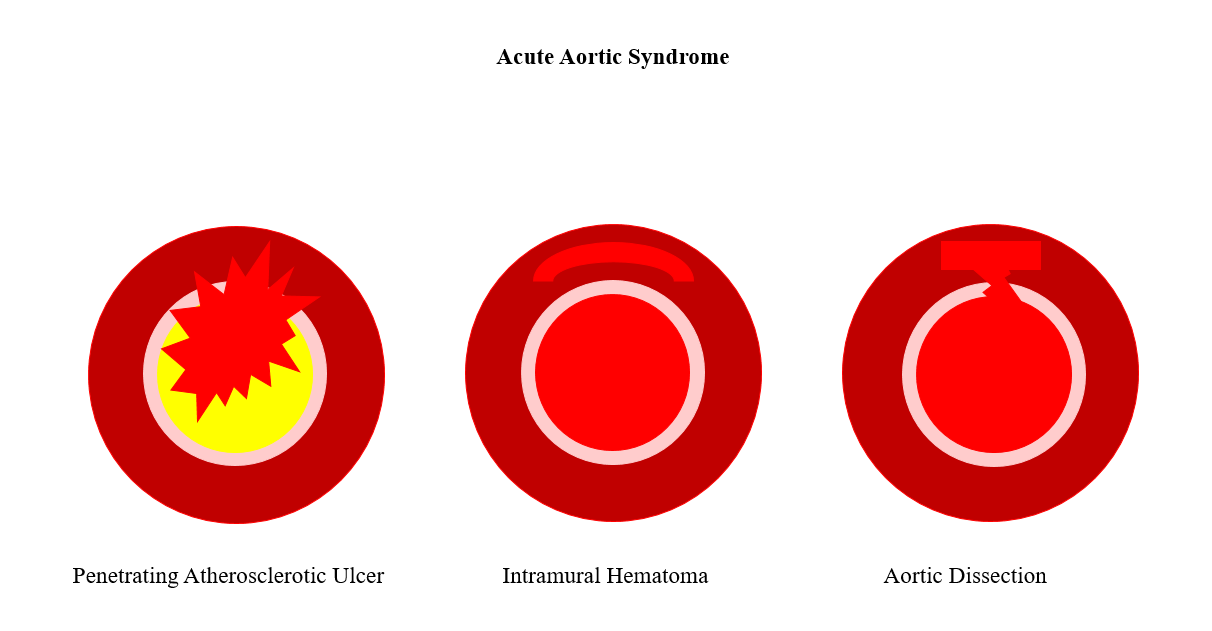Acute aortic syndrome: Difference between revisions
Jump to navigation
Jump to search
No edit summary |
No edit summary |
||
| Line 7: | Line 7: | ||
==Overview== | ==Overview== | ||
'''Acute aortic syndrome''' ('''AAS''') describes a constellation of emergency conditions with a similar clinical feature that involves the [[aorta]]. | '''Acute aortic syndrome''' ('''AAS''') describes a constellation of emergency conditions with a similar clinical feature that involves the [[aorta]]. These include [[aortic dissection]], intramural [[thrombus]], and [[penetrating atherosclerotic ulcer|penetrating atherosclerotic aortic ulcer]]. It is possible for AAS to lead to [[acute coronary syndrome]]. The term was introduced in 2001. | ||
==Classification== | ==Classification== | ||
Acute aortic syndromes is classified into 5 entities as follows:<ref name="Erbel2001">{{cite journal|last1=Erbel|first1=R|title=Diagnosis and management of aortic dissection Task Force on Aortic Dissection, European Society of Cardiology|journal=European Heart Journal|volume=22|issue=18|year=2001|pages=1642–1681|issn=0195668X|doi=10.1053/euhj.2001.2782}}</ref><ref>{{cite journal|title=2014 ESC Guidelines on the diagnosis and treatment of aortic diseases|journal=European Heart Journal|volume=35|issue=41|year=2014|pages=2873–2926|issn=0195-668X|doi=10.1093/eurheartj/ehu281}}</ref> | Acute aortic syndromes is classified into 5 entities as follows:<ref name="Erbel2001">{{cite journal|last1=Erbel|first1=R|title=Diagnosis and management of aortic dissection Task Force on Aortic Dissection, European Society of Cardiology|journal=European Heart Journal|volume=22|issue=18|year=2001|pages=1642–1681|issn=0195668X|doi=10.1053/euhj.2001.2782}}</ref><ref>{{cite journal|title=2014 ESC Guidelines on the diagnosis and treatment of aortic diseases|journal=European Heart Journal|volume=35|issue=41|year=2014|pages=2873–2926|issn=0195-668X|doi=10.1093/eurheartj/ehu281}}</ref> | ||
| Line 28: | Line 29: | ||
==Guidelines== | ==Guidelines== | ||
==2014 ESC Guidelines on the Diagnosis and Treatment of Aortic Diseases (DO NOT EDIT)<ref name="pmid25173340">{{cite journal |vauthors=Erbel R, Aboyans V, Boileau C, Bossone E, Bartolomeo RD, Eggebrecht H, Evangelista A, Falk V, Frank H, Gaemperli O, Grabenwöger M, Haverich A, Iung B, Manolis AJ, Meijboom F, Nienaber CA, Roffi M, Rousseau H, Sechtem U, Sirnes PA, Allmen RS, Vrints CJ |title=2014 ESC Guidelines on the diagnosis and treatment of aortic diseases: Document covering acute and chronic aortic diseases of the thoracic and abdominal aorta of the adult. The Task Force for the Diagnosis and Treatment of Aortic Diseases of the European Society of Cardiology (ESC) |journal=Eur. Heart J. |volume=35 |issue=41 |pages=2873–926 |date=November 2014 |pmid=25173340 |doi=10.1093/eurheartj/ehu281 |url=}}</ref>== | ==2014 ESC Guidelines on the Diagnosis and Treatment of Aortic Diseases (DO NOT EDIT)<ref name="pmid25173340">{{cite journal |vauthors=Erbel R, Aboyans V, Boileau C, Bossone E, Bartolomeo RD, Eggebrecht H, Evangelista A, Falk V, Frank H, Gaemperli O, Grabenwöger M, Haverich A, Iung B, Manolis AJ, Meijboom F, Nienaber CA, Roffi M, Rousseau H, Sechtem U, Sirnes PA, Allmen RS, Vrints CJ |title=2014 ESC Guidelines on the diagnosis and treatment of aortic diseases: Document covering acute and chronic aortic diseases of the thoracic and abdominal aorta of the adult. The Task Force for the Diagnosis and Treatment of Aortic Diseases of the European Society of Cardiology (ESC) |journal=Eur. Heart J. |volume=35 |issue=41 |pages=2873–926 |date=November 2014 |pmid=25173340 |doi=10.1093/eurheartj/ehu281 |url=}}</ref>== | ||
==References== | ==References== | ||
{{Reflist|2}} | {{Reflist|2}} | ||
Revision as of 03:02, 25 December 2019
 |
|
Acute aortic syndrome Microchapters |
Editor-In-Chief: C. Michael Gibson, M.S., M.D. [1]Associate Editor(s)-in-Chief: Sahar Memar Montazerin, M.D.[2]
Overview
Acute aortic syndrome (AAS) describes a constellation of emergency conditions with a similar clinical feature that involves the aorta. These include aortic dissection, intramural thrombus, and penetrating atherosclerotic aortic ulcer. It is possible for AAS to lead to acute coronary syndrome. The term was introduced in 2001.
Classification
Acute aortic syndromes is classified into 5 entities as follows:[1][2]
- Type I: classic aortic dissection involving an intimal layer between the true and false lumen (with no communication between the two lumen)
- Type II: aortic dissection with medial rupture and the subsequent intramural hematoma formation
- Type III: subtle aortic dissection with bulging of the aortic wall
- Type IV: aortic dissection due to plaque rupture and subsequent ulceration
- Type V: iatrogenic/traumatic dissection
Differentiating Acute Aortic Syndrome from other Diseases
- Acute aortic syndrome should be differentiated from other conditions causing signs and symptoms such as chest pain, dyspnea, back pain and etc.
- For more information on the differential diagnosis of the acute aortic syndrome click here.
Causes
- Causes include aortic dissection, intramural hematoma, penetrating atherosclerotic ulcer or a thoracic aneurysm that has become unstable.[3]
- Basically, AAS can be caused by a breakdown on the wall of the aorta that involves the tunica intima and/or media.[4]
- For more information on aortic dissection causes click here.
- For more information on aortic intramural hematoma causes click here.
- For more information on penetrating atherosclerotic aortic ulcer causes click here.
Guidelines
2014 ESC Guidelines on the Diagnosis and Treatment of Aortic Diseases (DO NOT EDIT)[5]
References
- ↑ Erbel, R (2001). "Diagnosis and management of aortic dissection Task Force on Aortic Dissection, European Society of Cardiology". European Heart Journal. 22 (18): 1642–1681. doi:10.1053/euhj.2001.2782. ISSN 0195-668X.
- ↑ "2014 ESC Guidelines on the diagnosis and treatment of aortic diseases". European Heart Journal. 35 (41): 2873–2926. 2014. doi:10.1093/eurheartj/ehu281. ISSN 0195-668X.
- ↑ Smith AD, Schoenhagen P (January 2008). "CT imaging for acute aortic syndrome". Cleve Clin J Med. 75 (1): 7–9, 12, 15–7 passim. doi:10.3949/ccjm.75.1.7. PMID 18236724.
- ↑ Evangelista Masip A (April 2007). "[Progress in the acute aortic syndrome]". Rev Esp Cardiol (in Spanish; Castilian). 60 (4): 428–39. doi:10.1157/13101646. PMID 17521551.
- ↑ Erbel R, Aboyans V, Boileau C, Bossone E, Bartolomeo RD, Eggebrecht H, Evangelista A, Falk V, Frank H, Gaemperli O, Grabenwöger M, Haverich A, Iung B, Manolis AJ, Meijboom F, Nienaber CA, Roffi M, Rousseau H, Sechtem U, Sirnes PA, Allmen RS, Vrints CJ (November 2014). "2014 ESC Guidelines on the diagnosis and treatment of aortic diseases: Document covering acute and chronic aortic diseases of the thoracic and abdominal aorta of the adult. The Task Force for the Diagnosis and Treatment of Aortic Diseases of the European Society of Cardiology (ESC)". Eur. Heart J. 35 (41): 2873–926. doi:10.1093/eurheartj/ehu281. PMID 25173340.